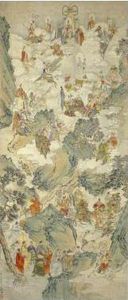Li Can Paintings
Li Can was a Chinese painter who lived during the Southern Song Dynasty. He is most renowned for his landscape paintings, which exemplify the exquisite and detailed style of the Southern Song period. Li Can was born in Qiantang (modern-day Hangzhou, Zhejiang province) and served as a court painter, which was a prestigious position at the time.
Li Can's paintings are characterized by their meticulous attention to detail and their portrayal of tranquil and lush sceneries. He was part of a tradition of literati painters who were skilled in poetry, calligraphy, and painting, but as a court painter, his works also reflect the more professionalized aspect of painting during the Song Dynasty. His landscapes typically feature mountains, waterfalls, rivers, and trees, composed with a sense of depth and serenity.
One of Li Can's most famous works is 'The Autumn Colors on the Qiao and Hua Mountains', which is a testament to his mastery of landscape painting. In this painting, Li Can depicted the mountains with a sense of majesty and grandeur, using fine brushwork to render the trees and rocks. His use of ink washes creates atmospheric effects that evoke a sense of the changing seasons.
Li Can's influence extended beyond his lifetime, impacting later generations of painters. His style contributed to the development of the Ma-Xia School, named after Ma Yuan and Xia Gui, two prominent painters of the subsequent generation who were inspired by Li Can's techniques and vision.
After his death in 1237, Li Can's legacy continued to be celebrated, and his works were highly prized by collectors. Today, Li Can is remembered as one of the great masters of Chinese landscape painting, and his works are studied for their technical brilliance and their evocative power. Though only a limited number of his original paintings have survived, those that remain offer a window into the sophisticated art and culture of the Southern Song Dynasty.

